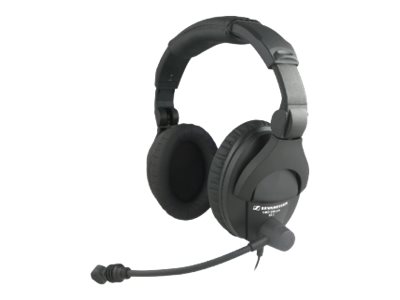
Complete technical specifications, details, expert ratings and review of Sennheiser HME 280 Intercom. Find out how your chosen headphones stack up against the competition and whether they are the ones that best meet your expectations with the headphone comparison feature.
| DESIGN AND DIMENSIONS Sennheiser HME 280 Intercom |
|---|
| Product Type | Headset - wired |
|---|
The Sennheiser HME 280 Intercom are wired headphones. In the case of studio and professional DJ headphones, a wired connection is a standard and a necessity. In this case, connecting via cable reduces audio transmission delays and prevents unwanted battery drain as it would be in case of wireless headphones. The same is de facto true for gaming headsets. In case of headphones for normal music listening, the cable is rather a relic, although it still has its fans. However, the wireless option is much more popular for everyday use in today’s world.
The design of the headphones is around the ears. Because of this design, the headphone envelops the entire ear and isolates the ear better from surrounding noise when listening compared to for example on-ear headphones. With that, they offer high-quality listening without interference. However, they are most likely heavier by design and less practical for frequent carrying.
| SOUND QUALITY Sennheiser HME 280 Intercom |
|---|
| Headphones Form Factor | Full size | |
|---|---|---|
| Headphones Technology | Dynamic | |
| Connectivity Technology | Wired | |
| Sound Output Mode | Stereo | |
| Total Harmonic Distortion (THD) | 1.0% | |
| Sensitivity | 104 dB | Better than 50 % of headphones rated. |
| Impedance | 64 Ohm |
The sound quality can be affected by many factors. The sensitivity parameter determines how sensitively the headphones can receive the signal from the source. The higher the sensitivity value, the louder the headphones will be able to play with less power consumption. In general, a higher listening volume also means a higher power load for the connected device. So if you're buying headphones to listen to music from your mobile phone, for example, this is relevant to think about as you don't want to drain your phone's battery too much. Lower values around 85 dB are more suitable for listening in more quiet environments (for example, at home or in the office). Medium values of around 90 dB can provide good listening quality in noisier environments (for example, on public transport or in cafés). Headphones with high sensitivity values of around 100 dB or more are designed for really noisy environments, such as concerts. The Sennheiser HME 280 Intercom has 104 dB.
The device connected to the headphones also plays a role most times. The lower impedance value (approximately 100 to 150 Ohms) is suitable for playback from mobile phones, laptops or other portable players that do not have a powerful enough amplifier. The lower impedance will ensure that the required volume level is achieved with less power, thus extending the life of the player. However, at the same time, with lower impedance, there is more distortion of the sound. Headphones with a higher impedance of around 250 Ohms and above are then more suitable for playback from really powerful signal sources or using a headphone amplifier, otherwise the sound coming out of them might not be loud enough. At the same time, higher-impedance headphones will also ensure less distortion in the sound. In the case of these headphones, the impedance reaches the 64 Ohm value. Total harmonic distortion is one of the parameters you will come across and usually includes the average value of the distortion when reproducing all frequency bands. This parameter is not critical when choosing headphones, but it is important to remember that higher harmonic distortion can negatively affect sound quality. In case of these headphones, the total harmonic distortion is Audio Output | Total Harmonic Distortion.
| MICROPHONE Sennheiser HME 280 Intercom |
|---|
| Type | Boom | |
|---|---|---|
| Microphone Technology | Electret condenser | |
| Frequency Response | 100 - 8500 Hz | Worse than 72 % of headphones rated. |
| Total Harmonic Distortion (THD) | 1.0% | Better than 90 % of headphones rated. |
Sennheiser HME 280 Intercom has a boom–type microphone. As with headphones, so-called harmonic distortion affects the sound quality of a microphone. Harmonic distortion above 5% is quite high and can lead to a reduction in recording quality. The average for most headphones is a distortion between 1 and 5%. For the average user, the recording quality of a headphone microphone in this interval should be perfectly adequate. Total harmonic distortion below 1% is more likely to be encountered in professional headphones. Such distortion is already considered very low and will ensure maximum recording quality. The total harmonic distortion of this microphone model is Microphone | Total Harmonic Distortion.
Show more| CABLE Sennheiser HME 280 Intercom |
|---|
| Cable Type | Headset cable - 1 m |
|---|
| OTHERS Sennheiser HME 280 Intercom |
|---|
| Bundled with | Sennheiser CSTD 01 | |
|---|---|---|
| Included Accessories | Wind screen |
Similar Headphones
Other Sennheiser Headphones